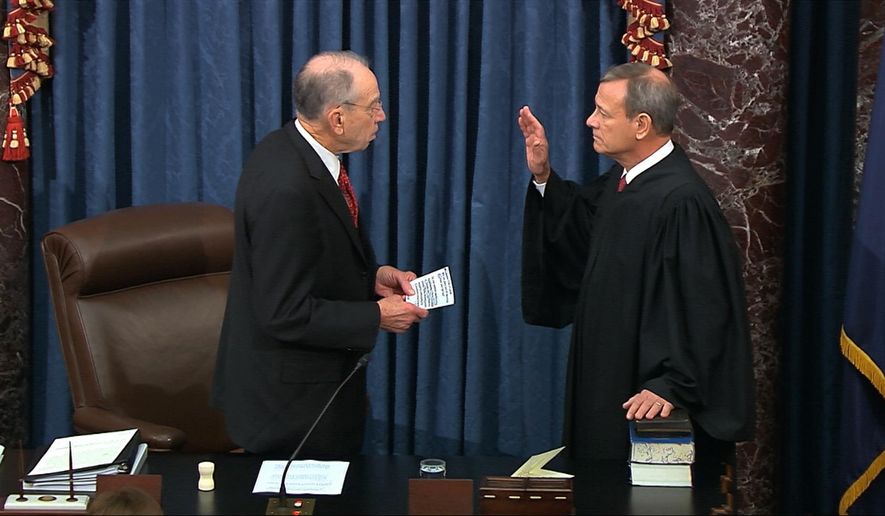Members of the Senate were sworn in Thursday as jurors for the impeachment trial of President Trump, vowing with right hands raised to afford “impartial justice.”
The solemn formality opened the third impeachment of a president in U.S. history and prepared the chamber to hear the House case against Mr. Trump beginning Tuesday.
The senators took the oath after Chief Justice of the United States John G. Roberts Jr. was sworn in to preside over the trial.
Justice Roberts then administered the oath to the senators: “I solemnly swear that in all things appertaining to the trial of the impeachment of Donald John Trump, now pending, I will do impartial justice according to the Constitution and laws, so help me God.”
After reciting the oath as a group, each member, in turn, signed the oath at the clerk’s desk in the well of the Senate.
Senate President Pro Tempore Charles E. Grassley, Iowa Republican, administered the oath to Justice Roberts.
SEE ALSO: Trump: Impeachment case in Senate ‘not going anywhere’
The rules for the proceedings, which are expected to mirror the impeachment trial of President Bill Clinton in 1999, will be established by a majority vote Tuesday.
The impeachment of Mr. Trump stems from a July 25 phone call in which he pressed Ukraine President Volodymyr Zelensky for a “favor” in investigating former Vice President Joseph R. Biden and Ukraine meddling in the 2016 election.
A whistleblower, who is believed to be a CIA official assigned to the White House, accused the president of abusing his power for personal gain on the call, including withholding $391 million of U.S. military aid from Ukraine as leverage.
The whistleblower also is believed to have ties to the Democratic Party and the elder Mr. Biden and is known to have met with Mr. Schiff’s staff for guidance before making the complaint.
A rough transcript of the call the White House released in late September did not show the president present a quid pro quo deal for the investigations, but Democrats said the threat was understood and part of an ongoing pressure campaign of “shadow” foreign policy conducted by Mr. Trump’s private lawyer, former New York Mayor Rudolph W. Giuliani.
New evidence the House Democrats obtained since passing the two articles of impeachment in a party-line vote Dec. 18 detail Mr. Giuliani’s activities in Ukraine but does not significantly change what was already known.
The articles rely heavily on testimony from Gordon Sondland, the ambassador to the European Union, who said he offered a prized White House visit for the newly elected Mr. Zelensky in exchange for his announcement of the investigations. But Mr. Sondland said he “presumed” that was what Mr. Trump wanted.
In his only conversation with the president about it, Mr. Trump told him that there was “no quid pro quo,” he testified.
None of the witnesses in the impeachment inquiry linked the holdup of military assistance to the investigations or provided a reason for the holdup. The aid was delayed for about two months, before the money started to flow to Ukraine on Sept. 11, two days after the Inspector General of the Intelligence Community informed Congress of the whistleblower complaint.
Mr. Trump has acknowledged that he wanted an investigation into alleged corruption involving the Bidens and Ukraine interference in the 2016 election.
Interest increased in Mr. Biden’s actions in Ukraine after he recently boasted of forcing Ukraine to fire the country’s chief prosecutor in spring 2016. He said threatened to block a $1 billion U.S. loan guarantee. The prosecutor was widely viewed as not doing enough to combat corruption. But the prosecutor, Viktor Shokin, also had looked into corruption allegations against Burisma and Mykola Zlochevsky, the Ukraine oligarch running the company.
Mr. Trump also wanted Ukraine to look into a missing Democratic National Committee server that was hacked by Russia during the 2016 presidential campaigns. An American cybersecurity company called CrowdStrike examined the server to probe the hack but the server disappeared before it got to the FBI.
Mr. Trump subscribes to an unsubstantiated theory that the server ended up in Ukraine.
• S.A. Miller can be reached at smiller@washingtontimes.com.
• Alex Swoyer can be reached at aswoyer@washingtontimes.com.




Please read our comment policy before commenting.